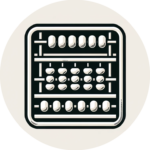COMPTEUR CIRCULAIRE, 1897
Inventor
Mr. BIZET
Invention date
Unknown
Manufacturing date:
1897
Manufacturing location
Unknown
Manufacturer
Unknown
Dimensions
L 20 W 23
Reference Number
018

History and Functionality
The “Compteur Circulaire” is an instrument designed by Mr. BIZET, School Director in Paris and Officer of Public Instruction in 1897.
According to its author:
“This intuitive teaching instrument allowed students to practise calculating in a classroom and immediately check the results of their work.” The “Compteur Circulaire” shows 100 juxtaposed bars that are grouped by tens. It is intended for educational and intuitive reasoning in processing the four operations,, especially multiplication and division. It is also kind of a “talking” multiplication and division device. Indeed, the multiples of 2, 3, 4,
6, 8, 9 are indicated by circle sections; those of 5, by a bold line separating the half-dozens and dozens, of those seven, by points corresponding to 7, 14, 21, etc…
The same table as the front one but without the numbers is set on the back of the instrument. The teacher recommends that each exercise done with the front (where the figures are) is repeated with the reverse side which has a silent face.
A quote from Ferdinand BUISSON reinforces the method proposed by M. BIZET: “The child must remember from having seen and not by dint of having recited.”
